Telemedicine in Australia: Barriers, Solutions, and Future Prospects
VerifiedAdded on 2023/01/13
|6
|1509
|89
Report
AI Summary
This report provides a comprehensive overview of telemedicine in Australia, addressing its challenges and potential solutions. It highlights the issues faced in healthcare delivery, particularly in rural and remote areas, and explores the adoption of telemedicine as a strategy to improve access and quality of care. The report categorizes the barriers to telemedicine uptake into technology-related and healthcare management issues, including funding, time constraints, infrastructure limitations, and skill gaps among healthcare practitioners. It further proposes solutions such as increased funding, intensive training programs, collaboration with telecommunication companies, and the use of advanced internet technologies. The report concludes by emphasizing the importance of telemedicine in achieving universal healthcare delivery across Australia, despite the challenges, and underscores the need for addressing the identified barriers through strategic interventions and collaboration among stakeholders.

Telemedicine in Australia
Name
Institution
Professor
Course
Date
Name
Institution
Professor
Course
Date
Paraphrase This Document
Need a fresh take? Get an instant paraphrase of this document with our AI Paraphraser
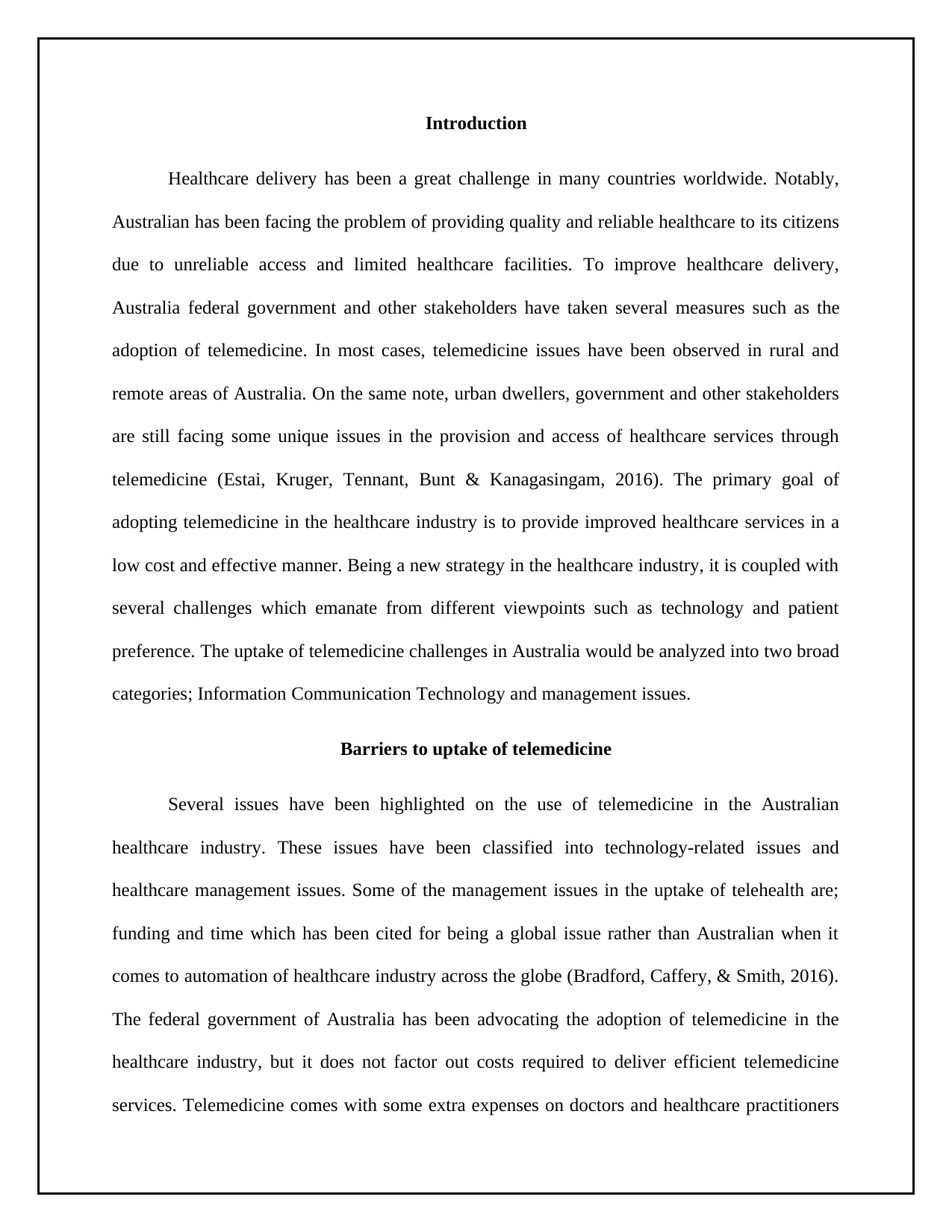
Introduction
Healthcare delivery has been a great challenge in many countries worldwide. Notably,
Australian has been facing the problem of providing quality and reliable healthcare to its citizens
due to unreliable access and limited healthcare facilities. To improve healthcare delivery,
Australia federal government and other stakeholders have taken several measures such as the
adoption of telemedicine. In most cases, telemedicine issues have been observed in rural and
remote areas of Australia. On the same note, urban dwellers, government and other stakeholders
are still facing some unique issues in the provision and access of healthcare services through
telemedicine (Estai, Kruger, Tennant, Bunt & Kanagasingam, 2016). The primary goal of
adopting telemedicine in the healthcare industry is to provide improved healthcare services in a
low cost and effective manner. Being a new strategy in the healthcare industry, it is coupled with
several challenges which emanate from different viewpoints such as technology and patient
preference. The uptake of telemedicine challenges in Australia would be analyzed into two broad
categories; Information Communication Technology and management issues.
Barriers to uptake of telemedicine
Several issues have been highlighted on the use of telemedicine in the Australian
healthcare industry. These issues have been classified into technology-related issues and
healthcare management issues. Some of the management issues in the uptake of telehealth are;
funding and time which has been cited for being a global issue rather than Australian when it
comes to automation of healthcare industry across the globe (Bradford, Caffery, & Smith, 2016).
The federal government of Australia has been advocating the adoption of telemedicine in the
healthcare industry, but it does not factor out costs required to deliver efficient telemedicine
services. Telemedicine comes with some extra expenses on doctors and healthcare practitioners
Healthcare delivery has been a great challenge in many countries worldwide. Notably,
Australian has been facing the problem of providing quality and reliable healthcare to its citizens
due to unreliable access and limited healthcare facilities. To improve healthcare delivery,
Australia federal government and other stakeholders have taken several measures such as the
adoption of telemedicine. In most cases, telemedicine issues have been observed in rural and
remote areas of Australia. On the same note, urban dwellers, government and other stakeholders
are still facing some unique issues in the provision and access of healthcare services through
telemedicine (Estai, Kruger, Tennant, Bunt & Kanagasingam, 2016). The primary goal of
adopting telemedicine in the healthcare industry is to provide improved healthcare services in a
low cost and effective manner. Being a new strategy in the healthcare industry, it is coupled with
several challenges which emanate from different viewpoints such as technology and patient
preference. The uptake of telemedicine challenges in Australia would be analyzed into two broad
categories; Information Communication Technology and management issues.
Barriers to uptake of telemedicine
Several issues have been highlighted on the use of telemedicine in the Australian
healthcare industry. These issues have been classified into technology-related issues and
healthcare management issues. Some of the management issues in the uptake of telehealth are;
funding and time which has been cited for being a global issue rather than Australian when it
comes to automation of healthcare industry across the globe (Bradford, Caffery, & Smith, 2016).
The federal government of Australia has been advocating the adoption of telemedicine in the
healthcare industry, but it does not factor out costs required to deliver efficient telemedicine
services. Telemedicine comes with some extra expenses on doctors and healthcare practitioners
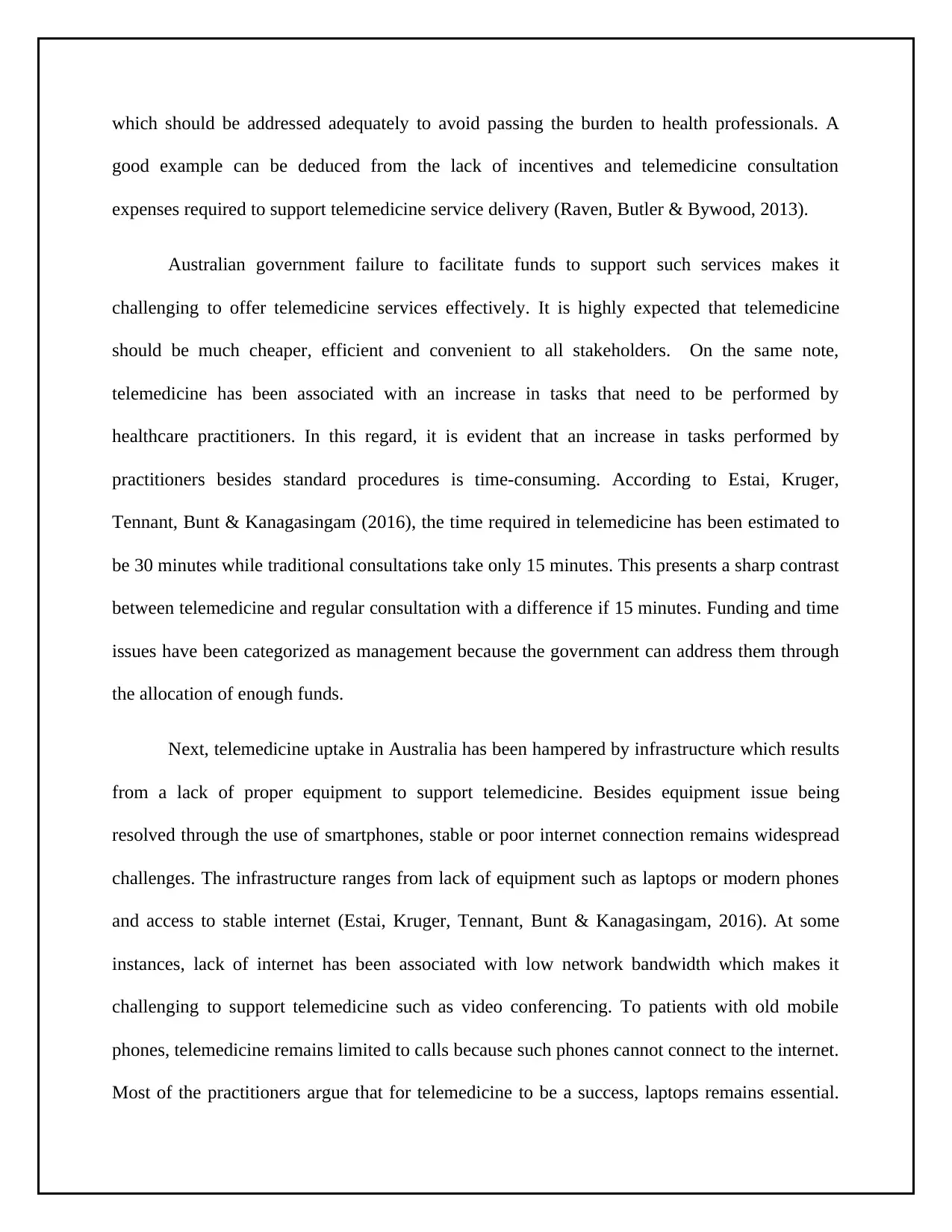
which should be addressed adequately to avoid passing the burden to health professionals. A
good example can be deduced from the lack of incentives and telemedicine consultation
expenses required to support telemedicine service delivery (Raven, Butler & Bywood, 2013).
Australian government failure to facilitate funds to support such services makes it
challenging to offer telemedicine services effectively. It is highly expected that telemedicine
should be much cheaper, efficient and convenient to all stakeholders. On the same note,
telemedicine has been associated with an increase in tasks that need to be performed by
healthcare practitioners. In this regard, it is evident that an increase in tasks performed by
practitioners besides standard procedures is time-consuming. According to Estai, Kruger,
Tennant, Bunt & Kanagasingam (2016), the time required in telemedicine has been estimated to
be 30 minutes while traditional consultations take only 15 minutes. This presents a sharp contrast
between telemedicine and regular consultation with a difference if 15 minutes. Funding and time
issues have been categorized as management because the government can address them through
the allocation of enough funds.
Next, telemedicine uptake in Australia has been hampered by infrastructure which results
from a lack of proper equipment to support telemedicine. Besides equipment issue being
resolved through the use of smartphones, stable or poor internet connection remains widespread
challenges. The infrastructure ranges from lack of equipment such as laptops or modern phones
and access to stable internet (Estai, Kruger, Tennant, Bunt & Kanagasingam, 2016). At some
instances, lack of internet has been associated with low network bandwidth which makes it
challenging to support telemedicine such as video conferencing. To patients with old mobile
phones, telemedicine remains limited to calls because such phones cannot connect to the internet.
Most of the practitioners argue that for telemedicine to be a success, laptops remains essential.
good example can be deduced from the lack of incentives and telemedicine consultation
expenses required to support telemedicine service delivery (Raven, Butler & Bywood, 2013).
Australian government failure to facilitate funds to support such services makes it
challenging to offer telemedicine services effectively. It is highly expected that telemedicine
should be much cheaper, efficient and convenient to all stakeholders. On the same note,
telemedicine has been associated with an increase in tasks that need to be performed by
healthcare practitioners. In this regard, it is evident that an increase in tasks performed by
practitioners besides standard procedures is time-consuming. According to Estai, Kruger,
Tennant, Bunt & Kanagasingam (2016), the time required in telemedicine has been estimated to
be 30 minutes while traditional consultations take only 15 minutes. This presents a sharp contrast
between telemedicine and regular consultation with a difference if 15 minutes. Funding and time
issues have been categorized as management because the government can address them through
the allocation of enough funds.
Next, telemedicine uptake in Australia has been hampered by infrastructure which results
from a lack of proper equipment to support telemedicine. Besides equipment issue being
resolved through the use of smartphones, stable or poor internet connection remains widespread
challenges. The infrastructure ranges from lack of equipment such as laptops or modern phones
and access to stable internet (Estai, Kruger, Tennant, Bunt & Kanagasingam, 2016). At some
instances, lack of internet has been associated with low network bandwidth which makes it
challenging to support telemedicine such as video conferencing. To patients with old mobile
phones, telemedicine remains limited to calls because such phones cannot connect to the internet.
Most of the practitioners argue that for telemedicine to be a success, laptops remains essential.
⊘ This is a preview!⊘
Do you want full access?
Subscribe today to unlock all pages.

Trusted by 1+ million students worldwide
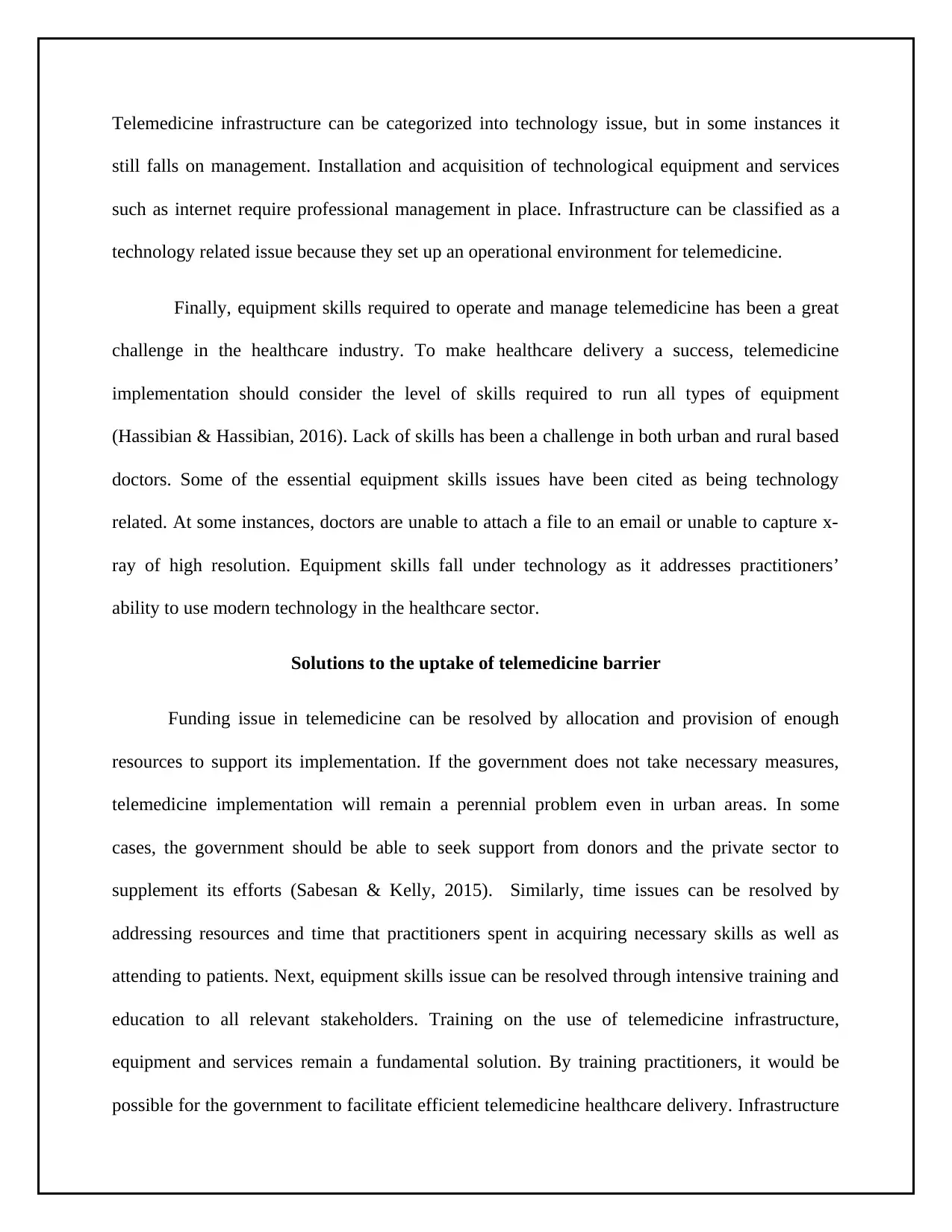
Telemedicine infrastructure can be categorized into technology issue, but in some instances it
still falls on management. Installation and acquisition of technological equipment and services
such as internet require professional management in place. Infrastructure can be classified as a
technology related issue because they set up an operational environment for telemedicine.
Finally, equipment skills required to operate and manage telemedicine has been a great
challenge in the healthcare industry. To make healthcare delivery a success, telemedicine
implementation should consider the level of skills required to run all types of equipment
(Hassibian & Hassibian, 2016). Lack of skills has been a challenge in both urban and rural based
doctors. Some of the essential equipment skills issues have been cited as being technology
related. At some instances, doctors are unable to attach a file to an email or unable to capture x-
ray of high resolution. Equipment skills fall under technology as it addresses practitioners’
ability to use modern technology in the healthcare sector.
Solutions to the uptake of telemedicine barrier
Funding issue in telemedicine can be resolved by allocation and provision of enough
resources to support its implementation. If the government does not take necessary measures,
telemedicine implementation will remain a perennial problem even in urban areas. In some
cases, the government should be able to seek support from donors and the private sector to
supplement its efforts (Sabesan & Kelly, 2015). Similarly, time issues can be resolved by
addressing resources and time that practitioners spent in acquiring necessary skills as well as
attending to patients. Next, equipment skills issue can be resolved through intensive training and
education to all relevant stakeholders. Training on the use of telemedicine infrastructure,
equipment and services remain a fundamental solution. By training practitioners, it would be
possible for the government to facilitate efficient telemedicine healthcare delivery. Infrastructure
still falls on management. Installation and acquisition of technological equipment and services
such as internet require professional management in place. Infrastructure can be classified as a
technology related issue because they set up an operational environment for telemedicine.
Finally, equipment skills required to operate and manage telemedicine has been a great
challenge in the healthcare industry. To make healthcare delivery a success, telemedicine
implementation should consider the level of skills required to run all types of equipment
(Hassibian & Hassibian, 2016). Lack of skills has been a challenge in both urban and rural based
doctors. Some of the essential equipment skills issues have been cited as being technology
related. At some instances, doctors are unable to attach a file to an email or unable to capture x-
ray of high resolution. Equipment skills fall under technology as it addresses practitioners’
ability to use modern technology in the healthcare sector.
Solutions to the uptake of telemedicine barrier
Funding issue in telemedicine can be resolved by allocation and provision of enough
resources to support its implementation. If the government does not take necessary measures,
telemedicine implementation will remain a perennial problem even in urban areas. In some
cases, the government should be able to seek support from donors and the private sector to
supplement its efforts (Sabesan & Kelly, 2015). Similarly, time issues can be resolved by
addressing resources and time that practitioners spent in acquiring necessary skills as well as
attending to patients. Next, equipment skills issue can be resolved through intensive training and
education to all relevant stakeholders. Training on the use of telemedicine infrastructure,
equipment and services remain a fundamental solution. By training practitioners, it would be
possible for the government to facilitate efficient telemedicine healthcare delivery. Infrastructure
Paraphrase This Document
Need a fresh take? Get an instant paraphrase of this document with our AI Paraphraser
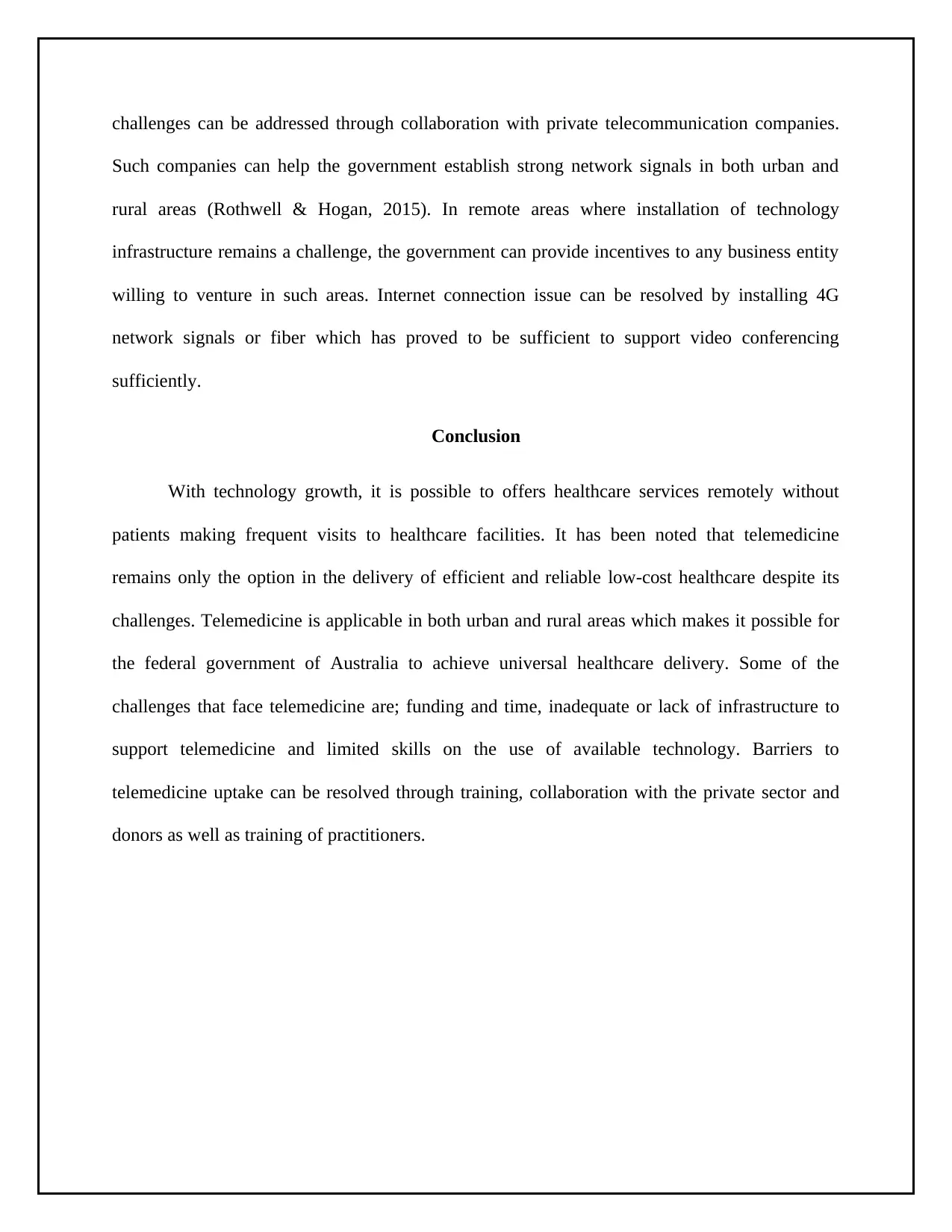
challenges can be addressed through collaboration with private telecommunication companies.
Such companies can help the government establish strong network signals in both urban and
rural areas (Rothwell & Hogan, 2015). In remote areas where installation of technology
infrastructure remains a challenge, the government can provide incentives to any business entity
willing to venture in such areas. Internet connection issue can be resolved by installing 4G
network signals or fiber which has proved to be sufficient to support video conferencing
sufficiently.
Conclusion
With technology growth, it is possible to offers healthcare services remotely without
patients making frequent visits to healthcare facilities. It has been noted that telemedicine
remains only the option in the delivery of efficient and reliable low-cost healthcare despite its
challenges. Telemedicine is applicable in both urban and rural areas which makes it possible for
the federal government of Australia to achieve universal healthcare delivery. Some of the
challenges that face telemedicine are; funding and time, inadequate or lack of infrastructure to
support telemedicine and limited skills on the use of available technology. Barriers to
telemedicine uptake can be resolved through training, collaboration with the private sector and
donors as well as training of practitioners.
Such companies can help the government establish strong network signals in both urban and
rural areas (Rothwell & Hogan, 2015). In remote areas where installation of technology
infrastructure remains a challenge, the government can provide incentives to any business entity
willing to venture in such areas. Internet connection issue can be resolved by installing 4G
network signals or fiber which has proved to be sufficient to support video conferencing
sufficiently.
Conclusion
With technology growth, it is possible to offers healthcare services remotely without
patients making frequent visits to healthcare facilities. It has been noted that telemedicine
remains only the option in the delivery of efficient and reliable low-cost healthcare despite its
challenges. Telemedicine is applicable in both urban and rural areas which makes it possible for
the federal government of Australia to achieve universal healthcare delivery. Some of the
challenges that face telemedicine are; funding and time, inadequate or lack of infrastructure to
support telemedicine and limited skills on the use of available technology. Barriers to
telemedicine uptake can be resolved through training, collaboration with the private sector and
donors as well as training of practitioners.
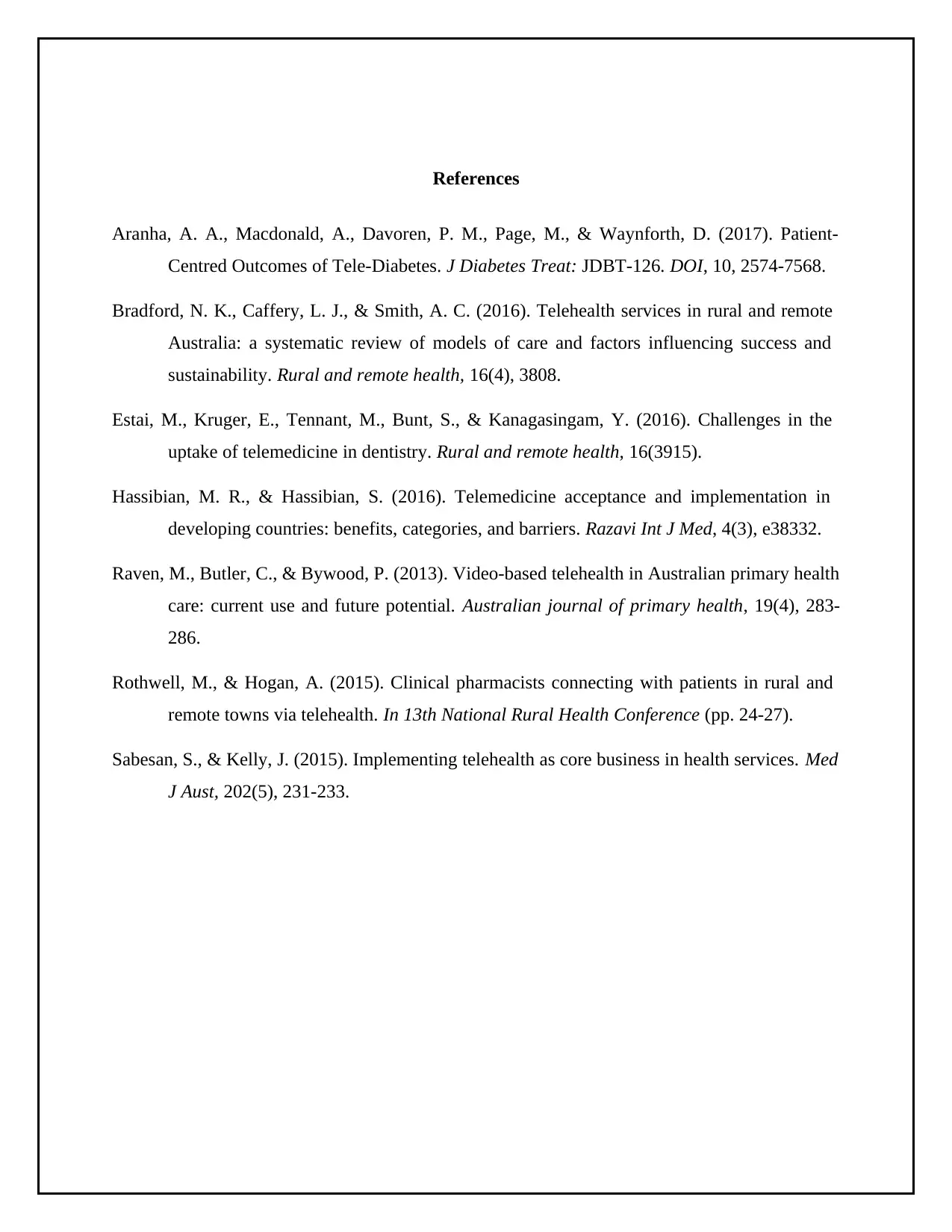
References
Aranha, A. A., Macdonald, A., Davoren, P. M., Page, M., & Waynforth, D. (2017). Patient-
Centred Outcomes of Tele-Diabetes. J Diabetes Treat: JDBT-126. DOI, 10, 2574-7568.
Bradford, N. K., Caffery, L. J., & Smith, A. C. (2016). Telehealth services in rural and remote
Australia: a systematic review of models of care and factors influencing success and
sustainability. Rural and remote health, 16(4), 3808.
Estai, M., Kruger, E., Tennant, M., Bunt, S., & Kanagasingam, Y. (2016). Challenges in the
uptake of telemedicine in dentistry. Rural and remote health, 16(3915).
Hassibian, M. R., & Hassibian, S. (2016). Telemedicine acceptance and implementation in
developing countries: benefits, categories, and barriers. Razavi Int J Med, 4(3), e38332.
Raven, M., Butler, C., & Bywood, P. (2013). Video-based telehealth in Australian primary health
care: current use and future potential. Australian journal of primary health, 19(4), 283-
286.
Rothwell, M., & Hogan, A. (2015). Clinical pharmacists connecting with patients in rural and
remote towns via telehealth. In 13th National Rural Health Conference (pp. 24-27).
Sabesan, S., & Kelly, J. (2015). Implementing telehealth as core business in health services. Med
J Aust, 202(5), 231-233.
Aranha, A. A., Macdonald, A., Davoren, P. M., Page, M., & Waynforth, D. (2017). Patient-
Centred Outcomes of Tele-Diabetes. J Diabetes Treat: JDBT-126. DOI, 10, 2574-7568.
Bradford, N. K., Caffery, L. J., & Smith, A. C. (2016). Telehealth services in rural and remote
Australia: a systematic review of models of care and factors influencing success and
sustainability. Rural and remote health, 16(4), 3808.
Estai, M., Kruger, E., Tennant, M., Bunt, S., & Kanagasingam, Y. (2016). Challenges in the
uptake of telemedicine in dentistry. Rural and remote health, 16(3915).
Hassibian, M. R., & Hassibian, S. (2016). Telemedicine acceptance and implementation in
developing countries: benefits, categories, and barriers. Razavi Int J Med, 4(3), e38332.
Raven, M., Butler, C., & Bywood, P. (2013). Video-based telehealth in Australian primary health
care: current use and future potential. Australian journal of primary health, 19(4), 283-
286.
Rothwell, M., & Hogan, A. (2015). Clinical pharmacists connecting with patients in rural and
remote towns via telehealth. In 13th National Rural Health Conference (pp. 24-27).
Sabesan, S., & Kelly, J. (2015). Implementing telehealth as core business in health services. Med
J Aust, 202(5), 231-233.
⊘ This is a preview!⊘
Do you want full access?
Subscribe today to unlock all pages.

Trusted by 1+ million students worldwide
1 out of 6
Related Documents
Your All-in-One AI-Powered Toolkit for Academic Success.
+13062052269
info@desklib.com
Available 24*7 on WhatsApp / Email
![[object Object]](/_next/static/media/star-bottom.7253800d.svg)
Unlock your academic potential
Copyright © 2020–2025 A2Z Services. All Rights Reserved. Developed and managed by ZUCOL.




